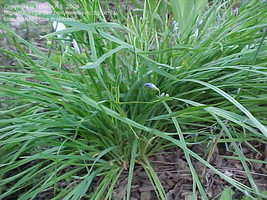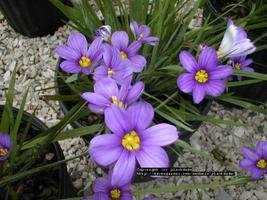





Blue-eyed grass (Sisyrinchium angustifolium) is one of our small, native plant treasures. As our sensibilities mature (along with the rest of our bodies), we become more appreciative of little things that add to the quality of our lives. We take time to see the spring violets, the trilliums, and a hundred other small beauties that we may not have noticed during our earlier years.
Blue-eyed grass (Sisyrinchium angustifolium) is one of the little plants that you may have missed. It blooms demurely on the edge of garden beds for a month to six weeks in spring and early summer. You have to look down to see it, and it doesn't scream, "Look at me, look at me!" You have to be paying attention and taking in the details.
One of about 75 species of Sisyrinchium native to the Western Hemisphere, blue-eyed grass can be recognized by the clusters of blue, violet, or white flowers with distinctly yellow eyes that bloom on branched flowering stems. Flowers are held a few inches above the narrow, grasslike, tufted clumps of foliage. It is native to the eastern two-thirds of the United States and Canada (Zones 4-9). Even though it goes by such common names as Eastern, stout, and narrow-leaf blue-eyed grass, it is not a grass, but a member of the iris family. Growing 6 to 12 inches tall, this demure herbaceous perennial spreads slowly.
Culture
Blue-eyed grass occurs naturally in wet fields and prairies. Its preference is for full sun and damp soil. However, if you don't have a wet field in full sun, do not despair. We as determined gardeners do what we can and are not put-off if we cannot meet every one of a plant's preferences. Blue-eyed grass gets along quite nicely in ordinary, well-drained but moist garden soil in sun to partial shade.
To maintain healthy and vigorous plants, divide clumps in early spring or fall every two or three years. Shearing back immediately after bloom will prevent the formation of unwanted seedlings and neaten up the planting. Most gardeners have friends who appreciate little starts of such attractive native plants. Simply pot up any extras and wait until the next friend stops by or until the next plant sale. Seedlings can also be transplanted to other places in your own garden or in the edge of the woods where space allows.
Propagation is easily accomplished by division of clumps or by sowing seeds. Seeds are best planted as soon as they are ripe, However, they will germinate fairly well the following spring if it is not possible to plant them right away.
Kinds
As many as 31 synonyms for Sisyrinchium angustifolium are listed in the Atlas of Florida Vascular Plants maintained by the University of South Florida. Commonly used synonyms are Sisyrinchium bermudiana, S. gramineum, and S. gramnoides. A commonly advertised cultivar 'Lucerne' sports lavender blue flowers and 'Album' sends up white blossoms. Many species of Sisyrinchium have been identified, and they are usually separated by characteristics like differing branch patterns and leaf lengths. 
Uses
For those who are trying to attract wildlife to their gardens, blue-eyed grass will serve well. Bees visit the flowers for pollen or nectar and seeds are attractive to prairie chickens, wild turkeys, and songbirds.
Blue-eyed grass is a star performer in rock gardens, cottage gardens, at the front of borders, and along pathways. Use it in woodland areas and allow it to naturalize in informal plantings. Combine it with other low-growing groundcovers like creeping thyme or dwarf sedum in more traditional settings.
Like many other native plants, many medicinal uses have been found for blue-eyed grass. Tea made from the roots was used by American Indians for treating diarrhea. Stomachaches were relieved by a tea made from the plants, and other concoctions have been used to treat various stomach and intestinal disorders.
Thanks to chicochi3 for the image of the clump of foliage, and to plantdude for the image of Sisyrinchium 'Lucerne'.Copyright © www.100flowers.win Botanic Garden All Rights Reserved